
A | B | C | D | E | F | G | H | CH | I | J | K | L | M | N | O | P | Q | R | S | T | U | V | W | X | Y | Z | 0 | 1 | 2 | 3 | 4 | 5 | 6 | 7 | 8 | 9
| Internet |
|---|
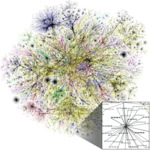 |
|
|
The history of the Internet has its origin in the efforts of scientists and engineers to build and interconnect computer networks. The Internet Protocol Suite, the set of rules used to communicate between networks and devices on the Internet, arose from research and development in the United States and involved international collaboration, particularly with researchers in the United Kingdom and France.[1][2][3]
Computer science was an emerging discipline in the late 1950s that began to consider time-sharing between computer users, and later, the possibility of achieving this over wide area networks. J. C. R. Licklider developed the idea of a universal network at the Information Processing Techniques Office (IPTO) of the United States Department of Defense (DoD) Advanced Research Projects Agency (ARPA). Independently, Paul Baran at the RAND Corporation proposed a distributed network based on data in message blocks in the early 1960s, and Donald Davies conceived of packet switching in 1965 at the National Physical Laboratory (NPL), proposing a national commercial data network in the United Kingdom.
ARPA awarded contracts in 1969 for the development of the ARPANET project, directed by Robert Taylor and managed by Lawrence Roberts. ARPANET adopted the packet switching technology proposed by Davies and Baran. The network of Interface Message Processors (IMPs) was built by a team at Bolt, Beranek, and Newman, with the design and specification led by Bob Kahn. The host-to-host protocol was specified by a group of graduate students at UCLA, led by Steve Crocker, along with Jon Postel and Vint Cerf. The ARPANET expanded rapidly across the United States with connections to the United Kingdom and Norway.
Several early packet-switched networks emerged in the 1970s which researched and provided data networking. Louis Pouzin and Hubert Zimmermann pioneered a simplified end-to-end approach to internetworking at the IRIA. Peter Kirstein put internetworking into practice at University College London in 1973. Bob Metcalfe developed the theory behind Ethernet and the PARC Universal Packet. ARPA projects, the International Network Working Group and commercial initiatives led to the development of various ideas for internetworking, in which multiple separate networks could be joined into a network of networks. Vint Cerf, now at Stanford University, and Bob Kahn, now at DARPA, published research in 1974 that evolved into the Transmission Control Protocol (TCP) and Internet Protocol (IP), two protocols of the Internet protocol suite. The design included concepts from the French CYCLADES project directed by Louis Pouzin. The development of packet switching networks was underpinned by mathematical work in the 1970s by Leonard Kleinrock at UCLA.
In the late 1970s, national and international public data networks emerged based on the X.25 protocol, designed by Rémi Després and others. In the United States, the National Science Foundation (NSF) funded national supercomputing centers at several universities in the United States, and provided interconnectivity in 1986 with the NSFNET project, thus creating network access to these supercomputer sites for research and academic organizations in the United States. International connections to NSFNET, the emergence of architecture such as the Domain Name System, and the adoption of TCP/IP on existing networks in the United States and around the world marked the beginnings of the Internet.[4][5][6] Commercial Internet service providers (ISPs) emerged in 1989 in the United States and Australia.[7] Limited private connections to parts of the Internet by officially commercial entities emerged in several American cities by late 1989 and 1990.[8] The optical backbone of the NSFNET was decommissioned in 1995, removing the last restrictions on the use of the Internet to carry commercial traffic, as traffic transitioned to optical networks managed by Sprint, MCI and AT&T in the United States.
Research at CERN in Switzerland by the British computer scientist Tim Berners-Lee in 1989–90 resulted in the World Wide Web, linking hypertext documents into an information system, accessible from any node on the network.[9] The dramatic expansion of the capacity of the Internet, enabled by the advent of wave division multiplexing (WDM) and the rollout of fiber optic cables in the mid-1990s, had a revolutionary impact on culture, commerce, and technology. This made possible the rise of near-instant communication by electronic mail, instant messaging, voice over Internet Protocol (VoIP) telephone calls, video chat, and the World Wide Web with its discussion forums, blogs, social networking services, and online shopping sites. Increasing amounts of data are transmitted at higher and higher speeds over fiber-optic networks operating at 1 Gbit/s, 10 Gbit/s, and 800 Gbit/s by 2019.[10] The Internet's takeover of the global communication landscape was rapid in historical terms: it only communicated 1% of the information flowing through two-way telecommunications networks in the year 1993, 51% by 2000, and more than 97% of the telecommunicated information by 2007.[11] The Internet continues to grow, driven by ever greater amounts of online information, commerce, entertainment, and social networking services. However, the future of the global network may be shaped by regional differences.[12]
Foundations
Precursors
- Telegraphy
- The practice of transmitting messages between two different places through an electromagnetic medium dates back to the electrical telegraph in the late 19th century, which was the first fully digital communication system. Radiotelegraphy began to be used commercially in the early 20th century. Telex became an operational teleprinter service in the 1930s. Such systems were limited to point-to-point communication between two end devices.
- Information theory
- Fundamental theoretical work in telecommunications technology was developed by Harry Nyquist and Ralph Hartley in the 1920s. Information theory, as enunciated by Claude Shannon in 1948, provided a firm theoretical underpinning to understand the trade-offs between signal-to-noise ratio, bandwidth, and error-free transmission in the presence of noise.
- Computers and modems
- Early fixed-program computers in the 1940s were operated manually by entering small programs via switches in order to load and run a series of programs. As transistor technology evolved in the 1950s, central processing units and user terminals came into use by 1955. The mainframe computer model was devised, and modems, such as the Bell 101, allowed digital data to be transmitted over regular unconditioned telephone lines at low speeds by the late 1950s. These technologies made it possible to exchange data between remote computers. However, a fixed-line link was still necessary; the point-to-point communication model did not allow for direct communication between any two arbitrary systems. In addition, the applications were specific and not general purpose. Examples included SAGE (1958) and SABRE (1960).
- Time-sharing
- Christopher Strachey, who became Oxford University's first Professor of Computation, filed a patent application in the United Kingdom for time-sharing in February 1959.[13][14] In June that year, he gave a paper "Time Sharing in Large Fast Computers" at the UNESCO Information Processing Conference in Paris where he passed the concept on to J. C. R. Licklider.[15][16] Licklider, a vice president at Bolt Beranek and Newman, Inc. (BBN), promoted the idea of time-sharing as an alternative to batch processing.[14] John McCarthy, at MIT, wrote a memo in 1959 that broadened the concept of time sharing to encompass multiple interactive user sessions, which resulted in the Compatible Time-Sharing System (CTSS) implemented at MIT. Other multi-user mainframe systems developed, such as PLATO at the University of Illinois Chicago.[17] In the early 1960, the Advanced Research Projects Agency (ARPA) of the United States Department of Defense funded further research into time-sharing at MIT through Project MAC.
Inspiration
J. C. R. Licklider, while working at BBN, proposed a computer network in his March 1960 paper Man-Computer Symbiosis:[18]
A network of such centers, connected to one another by wide-band communication lines the functions of present-day libraries together with anticipated advances in information storage and retrieval and symbiotic functions suggested earlier in this paper
In August 1962, Licklider and Welden Clark published the paper "On-Line Man-Computer Communication"[19] which was one of the first descriptions of a networked future.
In October 1962, Licklider was hired by Jack Ruina as director of the newly established Information Processing Techniques Office (IPTO) within ARPA, with a mandate to interconnect the United States Department of Defense's main computers at Cheyenne Mountain, the Pentagon, and SAC HQ. There he formed an informal group within DARPA to further computer research. He began by writing memos in 1963 describing a distributed network to the IPTO staff, whom he called "Members and Affiliates of the Intergalactic Computer Network".[20]
Although he left the IPTO in 1964, five years before the ARPANET went live, it was his vision of universal networking that provided the impetus for one of his successors, Robert Taylor, to initiate the ARPANET development. Licklider later returned to lead the IPTO in 1973 for two years.[21]
Packet switching

The infrastructure for telephone systems at the time was based on circuit switching, which requires pre-allocation of a dedicated communication line for the duration of the call. Telegram services had developed store and forward telecommunication techniques. Western Union's Automatic Telegraph Switching System Plan 55-A was based on message switching. The U.S. military's AUTODIN network became operational in 1962. These systems, like SAGE and SBRE, still required rigid routing structures that were prone to single point of failure.[24]
The technology was considered vulnerable for strategic and military use because there were no alternative paths for the communication in case of a broken link. In the early 1960s, Paul Baran of the RAND Corporation produced a study of survivable networks for the U.S. military in the event of nuclear war.[25] Information would be transmitted across a "distributed" network, divided into what he called "message blocks".[26][27][28][29][30]
In addition to being prone to a single point of failure, existing telegraphic techniques were inefficient and inflexible. Beginning in 1965 Donald Davies, at the National Physical Laboratory in the United Kingdom, developed a more advanced proposal of the concept, designed for high-speed computer networking, which he called packet switching, the term that would ultimately be adopted.[31][32][33][34]
Packet switching is a technique for transmitting computer data by splitting it into very short, standardized chunks, attaching routing information to each of these chunks, and transmitting them independently through a computer network. It provides better bandwidth utilization than traditional circuit-switching used for telephony, and enables the connection of computers with different transmission and receive rates. It is a distinct concept to message switching.[35]
Networks that led to the Internet
NPL network
Following discussions with J. C. R. Licklider in 1965, Donald Davies became interested in data communications for computer networks.[36][37] Later that year, at the National Physical Laboratory (NPL) in the United Kingdom, Davies designed and proposed a national commercial data network based on packet switching.[38] The following year, he described the use of "switching nodes" to act as routers in a digital communication network.[39][40] The proposal was not taken up nationally but he produced a design for a local network to serve the needs of the NPL and prove the feasibility of packet switching using high-speed data transmission.[41][42] To deal with packet permutations (due to dynamically updated route preferences) and to datagram losses (unavoidable when fast sources send to a slow destinations), he assumed that "all users of the network will provide themselves with some kind of error control",[43] thus inventing what came to be known as the end-to-end principle. In 1967, he and his team were the first to use the term 'protocol' in a modern data-commutation context.[44]
In 1968,[45] Davies began building the Mark I packet-switched network to meet the needs of the multidisciplinary laboratory and prove the technology under operational conditions.[46][47] The network's development was described at a 1968 conference.[48][49] Elements of the network became operational in early 1969,[46][50] the first implementation of packet switching,[51][52] and the NPL network was the first to use high-speed links.[53] Many other packet switching networks built in the 1970s were similar "in nearly all respects" to Davies' original 1965 design.[36] The Mark II version which operated from 1973 used a layered protocol architecture.[53] In 1976, 12 computers and 75 terminal devices were attached,[54] and more were added. The NPL team carried out simulation work on wide-area packet networks, including datagrams and congestion; and research into internetworking and secure communications.[46][55][56] The network was replaced in 1986.[53]
ARPANET
Robert Taylor was promoted to the head of the Information Processing Techniques Office (IPTO) at Defense Advanced Research Projects Agency (DARPA) in 1966. He intended to realize Licklider's ideas of an interconnected networking system.[57] As part of the IPTO's role, three network terminals had been installed: one for System Development Corporation in Santa Monica, one for Project Genie at University of California, Berkeley, and one for the Compatible Time-Sharing System project at Massachusetts Institute of Technology (MIT).[58] Taylor's identified need for networking became obvious from the waste of resources apparent to him.
For each of these three terminals, I had three different sets of user commands. So if I was talking online with someone at S.D.C. and I wanted to talk to someone I knew at Berkeley or M.I.T. about this, I had to get up from the S.D.C. terminal, go over and log into the other terminal and get in touch with them.... I said, oh man, it's obvious what to do: If you have these three terminals, there ought to be one terminal that goes anywhere you want to go where you have interactive computing. That idea is the ARPAnet.[58]
Bringing in Larry Roberts from MIT in January 1967, he initiated a project to build such a network. Roberts and Thomas Merrill had been researching computer time-sharing over wide area networks (WANs).[59] Wide area networks emerged during the late 1950s and became established during the 1960s. At the first ACM Symposium on Operating Systems Principles in October 1967, Roberts presented a proposal for the "ARPA net", based on Wesley Clark's idea to use Interface Message Processors (IMP) to create a message switching network.[60][61][62] At the conference, Roger Scantlebury presented Donald Davies' work on a hierarchical digital communications network using packet switching and referenced the work of Paul Baran at RAND. Roberts incorporated the packet switching and routing concepts of Davies and Baran into the ARPANET design and upgraded the proposed communications speed from 2.4 kbit/s to 50 kbit/s.[22][63][64][65]
ARPA awarded the contract to build the network to Bolt Beranek & Newman. The "IMP guys", led by Frank Heart and Bob Kahn, developed the routing, flow control, software design and network control.[36][66] The first ARPANET link was established between the Network Measurement Center at the University of California, Los Angeles (UCLA) Henry Samueli School of Engineering and Applied Science directed by Leonard Kleinrock, and the NLS system at Stanford Research Institute (SRI) directed by Douglas Engelbart in Menlo Park, California at 22:30 hours on October 29, 1969.[67]
"We set up a telephone connection between us and the guys at SRI ...", Kleinrock ... said in an interview: "We typed the L and we asked on the phone,
- "Do you see the L?"
- "Yes, we see the L," came the response.
- We typed the O, and we asked, "Do you see the O."
- "Yes, we see the O."
- Then we typed the G, and the system crashed ...
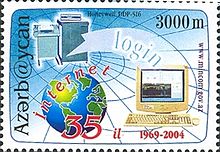
By December 1969, a four-node network was connected by adding the Culler-Fried Interactive Mathematics Center at the University of California, Santa Barbara followed by the University of Utah Graphics Department.[70] In the same year, Taylor helped fund ALOHAnet, a system designed by professor Norman Abramson and others at the University of Hawaiʻi at Mānoa that transmitted data by radio between seven computers on four islands on Hawaii.[71]
Steve Crocker formed the "Network Working Group" in 1969 at UCLA. Working with Jon Postel and Vint Cerf, he initiated and managed the Request for Comments (RFC) process, which is still used today for proposing and distributing contributions. RFC 1, entitled "Host Software", was written by Steve Crocker and published on April 7, 1969. The protocol for establishing links between network sites in the ARPANET, the Network Control Program (NCP), was completed in 1970. These early years were documented in the 1972 film Computer Networks: The Heralds of Resource Sharing.
Roberts presented the idea of packet switching to the communication professionals, and faced anger and hostility. Before ARPANET was operating, they argued that the router buffers would quickly run out. After the ARPANET was operating, they argued packet switching would never be economic without the government subsidy. Baran faced the same rejection and thus failed to convince the military into constructing a packet switching network.[72][73]
Early international collaborations via the ARPANET were sparse. Connections were made in 1973 to the Norwegian Seismic Array (NORSAR),[74] via a satellite link at the Tanum Earth Station in Sweden, and to Peter Kirstein's research group at University College London, which provided a gateway to British academic networks, the first international heterogenous resource sharing network.[75] Throughout the 1970s, Leonard Kleinrock developed the mathematical theory to model and measure the performance of packet-switching technology, building on his earlier work on the application of queueing theory to message switching systems.[76] By 1981, the number of hosts had grown to 213.[77] The ARPANET became the technical core of what would become the Internet, and a primary tool in developing the technologies used.
Merit Network
The Merit Network[78] was formed in 1966 as the Michigan Educational Research Information Triad to explore computer networking between three of Michigan's public universities as a means to help the state's educational and economic development.[79] With initial support from the State of Michigan and the National Science Foundation (NSF), the packet-switched network was first demonstrated in December 1971 when an interactive host to host connection was made between the IBM mainframe computer systems at the University of Michigan in Ann Arbor and Wayne State University in Detroit.[80] In October 1972 connections to the CDC mainframe at Michigan State University in East Lansing completed the triad. Over the next several years in addition to host to host interactive connections the network was enhanced to support terminal to host connections, host to host batch connections (remote job submission, remote printing, batch file transfer), interactive file transfer, gateways to the Tymnet and Telenet public data networks, X.25 host attachments, gateways to X.25 data networks, Ethernet attached hosts, and eventually TCP/IP and additional public universities in Michigan join the network.[80][81] All of this set the stage for Merit's role in the NSFNET project starting in the mid-1980s.
CYCLADES
The CYCLADES packet switching network was a French research network designed and directed by Louis Pouzin.[82] In 1972, he began planning the network to explore alternatives to the early ARPANET design and to support internetworking research. First demonstrated in 1973, it was the first network to implement the end-to-end principle conceived by Donald Davies and make the hosts responsible for reliable delivery of data, rather than the network itself, using unreliable datagrams. Concepts implemented in this network influenced TCP/IP architecture.[83][84][82]
X.25 and public data networks
Based on international research initiatives, particularly the contributions of Rémi Després, packet switching network standards were developed by the International Telegraph and Telephone Consultative Committee (ITU-T) in the form of X.25 and related standards.[85][86] X.25 is built on the concept of virtual circuits emulating traditional telephone connections. In 1974, X.25 formed the basis for the SERCnet network between British academic and research sites, which later became JANET, the United Kingdom's high-speed national research and education network (NREN). The initial ITU Standard on X.25 was approved in March 1976.[87] Existing networks, such as Telenet in the United States adopted X.25 as well as new public data networks, such as DATAPAC in Canada and TRANSPAC in France.[85][86] X.25 was supplemented by the X.75 protocol which enabled internetworking between national PTT networks in Europe and commercial networks in North America.[88][89][90]
The British Post Office, Western Union International, and Tymnet collaborated to create the first international packet-switched network, referred to as the International Packet Switched Service (IPSS), in 1978. This network grew from Europe and the US to cover Canada, Hong Kong, and Australia by 1981. By the 1990s it provided a worldwide networking infrastructure.[91]
Unlike ARPANET, X.25 was commonly available for business use. Telenet offered its Telemail electronic mail service, which was also targeted to enterprise use rather than the general email system of the ARPANET.
The first public dial-in networks used asynchronous teleprinter (TTY) terminal protocols to reach a concentrator operated in the public network. Some networks, such as Telenet and CompuServe, used X.25 to multiplex the terminal sessions into their packet-switched backbones, while others, such as Tymnet, used proprietary protocols. In 1979, CompuServe became the first service to offer electronic mail capabilities and technical support to personal computer users. The company broke new ground again in 1980 as the first to offer real-time chat with its CB Simulator. Other major dial-in networks were America Online (AOL) and Prodigy that also provided communications, content, and entertainment features.[92] Many bulletin board system (BBS) networks also provided on-line access, such as FidoNet which was popular amongst hobbyist computer users, many of them hackers and amateur radio operators.[citation needed]
UUCP and Usenet
In 1979, two students at Duke University, Tom Truscott and Jim Ellis, originated the idea of using Bourne shell scripts to transfer news and messages on a serial line UUCP connection with nearby University of North Carolina at Chapel Hill. Following public release of the software in 1980, the mesh of UUCP hosts forwarding on the Usenet news rapidly expanded. UUCPnet, as it would later be named, also created gateways and links between FidoNet and dial-up BBS hosts. UUCP networks spread quickly due to the lower costs involved, ability to use existing leased lines, X.25 links or even ARPANET connections, and the lack of strict use policies compared to later networks like CSNET and BITNET. All connects were local. By 1981 the number of UUCP hosts had grown to 550, nearly doubling to 940 in 1984.[93]
Sublink Network, operating since 1987 and officially founded in Italy in 1989, based its interconnectivity upon UUCP to redistribute mail and news groups messages throughout its Italian nodes (about 100 at the time) owned both by private individuals and small companies. Sublink Network evolved into one of the first examples of Internet technology coming into use through popular diffusion.
1973–1989: Merging the networks and creating the Internet
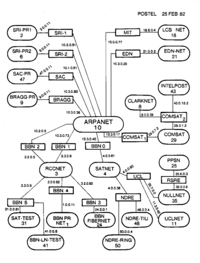
TCP/IP
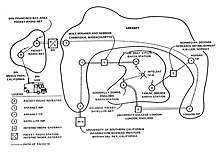
With so many different networking methods seeking interconnection, a method was needed to unify them. Louis Pouzin initiated the CYCLADES project in 1972,[94] building on the work of Donald Davies and the ARPANET.[95] An International Network Working Group formed in 1972; active members included Vint Cerf from Stanford University, Alex McKenzie from BBN, Donald Davies and Roger Scantlebury from NPL, and Louis Pouzin and Hubert Zimmermann from IRIA.[96][97][98] Pouzin coined the term catenet for concatenated network. Bob Metcalfe at Xerox PARC outlined the idea of Ethernet and PARC Universal Packet (PUP) for internetworking. Bob Kahn, now at DARPA, recruited Vint Cerf to work with him on the problem. By 1973, these groups had worked out a fundamental reformulation, in which the differences between network protocols were hidden by using a common internetworking protocol. Instead of the network being responsible for reliability, as in the ARPANET, the hosts became responsible.[2][99]
Cerf and Kahn published their ideas in May 1974,[100] which incorporated concepts implemented by Louis Pouzin and Hubert Zimmermann in the CYCLADES network.[101] The specification of the resulting protocol, the Transmission Control Program, was published as RFC 675 by the Network Working Group in December 1974.[102] It contains the first attested use of the term internet, as a shorthand for internetwork. This software was monolithic in design using two simplex communication channels for each user session.
With the role of the network reduced to a core of functionality, it became possible to exchange traffic with other networks independently from their detailed characteristics, thereby solving the fundamental problems of internetworking. DARPA agreed to fund the development of prototype software. Testing began in 1975 through concurrent implementations at Stanford, BBN and University College London (UCL).[3] After several years of work, the first demonstration of a gateway between the Packet Radio network (PRNET) in the SF Bay area and the ARPANET was conducted by the Stanford Research Institute. On November 22, 1977, a three network demonstration was conducted including the ARPANET, the SRI's Packet Radio Van on the Packet Radio Network and the Atlantic Packet Satellite Network (SATNET) including a node at UCL.[103][104]
The software was redesigned as a modular protocol stack, using full-duplex channels; between 1976 and 1977, Yogen Dalal and Robert Metcalfe among others, proposed separating TCP's routing and transmission control functions into two discrete layers,[105][106] which led to the splitting of the Transmission Control Program into the Transmission Control Protocol (TCP) and the Internet Protocol (IP) in version 3 in 1978.[106][107] Version 4 was described in IETF publication RFC 791 (September 1981), 792 and 793. It was installed on SATNET in 1982 and the ARPANET in January 1983 after the DoD made it standard for all military computer networking.[108][109] This resulted in a networking model that became known informally as TCP/IP. It was also referred to as the Department of Defense (DoD) model or DARPA model.[110] Cerf credits his graduate students Yogen Dalal, Carl Sunshine, Judy Estrin, Richard Karp, and Gérard Le Lann with important work on the design and testing.[111] DARPA sponsored or encouraged the development of TCP/IP implementations for many operating systems.

From ARPANET to NSFNET
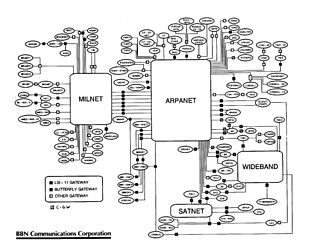
After the ARPANET had been up and running for several years, ARPA looked for another agency to hand off the network to; ARPA's primary mission was funding cutting-edge research and development, not running a communications utility. In July 1975, the network was turned over to the Defense Communications Agency, also part of the Department of Defense. In 1983, the U.S. military portion of the ARPANET was broken off as a separate network, the MILNET. MILNET subsequently became the unclassified but military-only NIPRNET, in parallel with the SECRET-level SIPRNET and JWICS for TOP SECRET and above. NIPRNET does have controlled security gateways to the public Internet.
The networks based on the ARPANET were government funded and therefore restricted to noncommercial uses such as research; unrelated commercial use was strictly forbidden.[112] This initially restricted connections to military sites and universities. During the 1980s, the connections expanded to more educational institutions, and a growing number of companies such as Digital Equipment Corporation and Hewlett-Packard, which were participating in research projects or providing services to those who were. Data transmission speeds depended upon the type of connection, the slowest being analog telephone lines and the fastest using optical networking technology.
Several other branches of the U.S. government, the National Aeronautics and Space Administration (NASA), the National Science Foundation (NSF), and the Department of Energy (DOE) became heavily involved in Internet research and started development of a successor to ARPANET. In the mid-1980s, all three of these branches developed the first Wide Area Networks based on TCP/IP. NASA developed the NASA Science Network, NSF developed CSNET and DOE evolved the Energy Sciences Network or ESNet.

NASA developed the TCP/IP based NASA Science Network (NSN) in the mid-1980s, connecting space scientists to data and information stored anywhere in the world. In 1989, the DECnet-based Space Physics Analysis Network (SPAN) and the TCP/IP-based NASA Science Network (NSN) were brought together at NASA Ames Research Center creating the first multiprotocol wide area network called the NASA Science Internet, or NSI. NSI was established to provide a totally integrated communications infrastructure to the NASA scientific community for the advancement of earth, space and life sciences. As a high-speed, multiprotocol, international network, NSI provided connectivity to over 20,000 scientists across all seven continents.
In 1981, NSF supported the development of the Computer Science Network (CSNET). CSNET connected with ARPANET using TCP/IP, and ran TCP/IP over X.25, but it also supported departments without sophisticated network connections, using automated dial-up mail exchange. CSNET played a central role in popularizing the Internet outside the ARPANET.[23]
In 1986, the NSF created NSFNET, a 56 kbit/s backbone to support the NSF-sponsored supercomputing centers. The NSFNET also provided support for the creation of regional research and education networks in the United States, and for the connection of university and college campus networks to the regional networks.[113] The use of NSFNET and the regional networks was not limited to supercomputer users and the 56 kbit/s network quickly became overloaded. NSFNET was upgraded to 1.5 Mbit/s in 1988 under a cooperative agreement with the Merit Network in partnership with IBM, MCI, and the State of Michigan. The existence of NSFNET and the creation of Federal Internet Exchanges (FIXes) allowed the ARPANET to be decommissioned in 1990.
NSFNET was expanded and upgraded to dedicated fiber, optical lasers and optical amplifier systems capable of delivering T3 start up speeds or 45 Mbit/s in 1991. However, the T3 transition by MCI took longer than expected, allowing Sprint to establish a coast-to-coast long-distance commercial Internet service. When NSFNET was decommissioned in 1995, its optical networking backbones were handed off to several commercial Internet service providers, including MCI, PSI Net and Sprint.[114] As a result, when the handoff was complete, Sprint and its Washington DC Network Access Points began to carry Internet traffic, and by 1996, Sprint was the world's largest carrier of Internet traffic.[115]
The research and academic community continues to develop and use advanced networks such as Internet2 in the United States and JANET in the United Kingdom.
Transition towards the Internet
The term "internet" was reflected in the first RFC published on the TCP protocol (RFC 675:[116] Internet Transmission Control Program, December 1974) as a short form of internetworking, when the two terms were used interchangeably. In general, an internet was a collection of networks linked by a common protocol. In the time period when the ARPANET was connected to the newly formed NSFNET project in the late 1980s, the term was used as the name of the network, Internet, being the large and global TCP/IP network.[117]
Opening the Internet and the fiber optic backbone to corporate and consumers increased demand for network capacity. The expense and delay of laying new fiber led providers to test a fiber bandwidth expansion alternative that had been pioneered in the late 1970s by Optelecom using "interactions between light and matter, such as lasers and optical devices used for optical amplification and wave mixing".[118] This technology became known as wave division multiplexing (WDM). Bell Labs deployed a 4-channel WDM system in 1995.[119] To develop a mass capacity (dense) WDM system, Optelecom and its former head of Light Systems Research, David R. Huber formed a new venture, Ciena Corp., that deployed the world's first dense WDM system on the Sprint fiber network in June 1996.[119] This was referred to as the real start of optical networking.[120]
As interest in networking grew by needs of collaboration, exchange of data, and access of remote computing resources, the Internet technologies spread throughout the rest of the world. The hardware-agnostic approach in TCP/IP supported the use of existing network infrastructure, such as the International Packet Switched Service (IPSS) X.25 network, to carry Internet traffic.
Many sites unable to link directly to the Internet created simple gateways for the transfer of electronic mail, the most important application of the time. Sites with only intermittent connections used UUCP or FidoNet and relied on the gateways between these networks and the Internet. Some gateway services went beyond simple mail peering, such as allowing access to File Transfer Protocol (FTP) sites via UUCP or mail.[121]
Finally, routing technologies were developed for the Internet to remove the remaining centralized routing aspects. The Exterior Gateway Protocol (EGP) was replaced by a new protocol, the Border Gateway Protocol (BGP). This provided a meshed topology for the Internet and reduced the centric architecture which ARPANET had emphasized. In 1994, Classless Inter-Domain Routing (CIDR) was introduced to support better conservation of address space which allowed use of route aggregation to decrease the size of routing tables.[122]
Optical networking
The MOS transistor underpinned the rapid growth of telecommunication bandwidth over the second half of the 20th century.[123] To address the need for transmission capacity beyond that provided by radio, satellite and analog copper telephone lines, engineers developed optical communications systems based on fiber optic cables powered by lasers and optical amplifier techniques.
The concept of lasing arose from a 1917 paper by Albert Einstein, "On the Quantum Theory of Radiation." Einstein expanded upon a dialog with Max Planck on how atoms absorb and emit light, part of a thought process that, with input from Erwin Schrödinger, Werner Heisenberg and others, gave rise to Quantum Mechanics. Specifically, in his quantum theory, Einstein mathematically determined that light could be generated not only by spontaneous emission, such as the light emitted by an incandescent light or the Sun, but also by stimulated emission.
Forty years later, on November 13, 1957, Columbia University physics student Gordon Gould first realized how to make light by stimulated emission through a process of optical amplification. He coined the term LASER for this technology—Light Amplification by Stimulated Emission of Radiation.[124] Using Gould's light amplification method (patented as "Optically Pumped Laser Amplifier"),[125] Theodore Maiman made the first working laser on May 16, 1960.[126]
Gould co-founded Optelecom, Inc. in 1973 to commercialize his inventions in optical fiber telecommunications.[127] just as Corning Glass was producing the first commercial fiber optic cable in small quantities. Optelecom configured its own fiber lasers and optical amplifiers into the first commercial optical communication systems which it delivered to Chevron and the US Army Missile Defense.[128] Three years later, GTE deployed the first optical telephone system in 1977 in Long Beach, California.[129] By the early 1980s, optical networks powered by lasers, LED and optical amplifier equipment supplied by Bell Labs, NTT and Perelli were used by select universities and long-distance telephone providers.
TCP/IP goes global (1980s)
CERN and the European Internet
In 1982, NORSAR and Peter Kirstein's research group at University College London (UCL) left the ARPANET and began to use TCP/IP over SATNET.[99] There were 40 British academic research groups using UCL's link to the ARPANET in 1975.[75][130]
Between 1984 and 1988, CERN began installation and operation of TCP/IP to interconnect its major internal computer systems, workstations, PCs, and an accelerator control system. CERN continued to operate a limited self-developed system (CERNET) internally and several incompatible (typically proprietary) network protocols externally. There was considerable resistance in Europe towards more widespread use of TCP/IP, and the CERN TCP/IP intranets remained isolated from the Internet until 1989, when a transatlantic connection to Cornell University was established.[131][132][133]
Zdroj:https://en.wikipedia.org?pojem=History_of_the_Internet
Text je dostupný za podmienok Creative Commons Attribution/Share-Alike License 3.0 Unported; prípadne za ďalších podmienok. Podrobnejšie informácie nájdete na stránke Podmienky použitia.
Antropológia
Aplikované vedy
Bibliometria
Dejiny vedy
Encyklopédie
Filozofia vedy
Forenzné vedy
Humanitné vedy
Knižničná veda
Kryogenika
Kryptológia
Kulturológia
Literárna veda
Medzidisciplinárne oblasti
Metódy kvantitatívnej analýzy
Metavedy
Metodika
Text je dostupný za podmienok Creative
Commons Attribution/Share-Alike License 3.0 Unported; prípadne za ďalších
podmienok.
Podrobnejšie informácie nájdete na stránke Podmienky
použitia.
www.astronomia.sk | www.biologia.sk | www.botanika.sk | www.dejiny.sk | www.economy.sk | www.elektrotechnika.sk | www.estetika.sk | www.farmakologia.sk | www.filozofia.sk | Fyzika | www.futurologia.sk | www.genetika.sk | www.chemia.sk | www.lingvistika.sk | www.politologia.sk | www.psychologia.sk | www.sexuologia.sk | www.sociologia.sk | www.veda.sk I www.zoologia.sk
